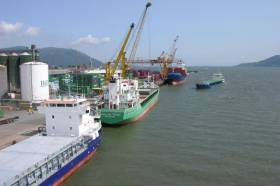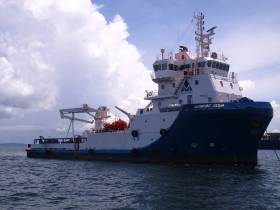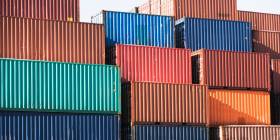Displaying items by tag: Port and Shipping News
European Sea Ports Organisation to “Think Climate”
#ThinkClimate- Tackling global climate change is a concern of all European ports. In this spirit and in the light of the Paris Climate Conference last December, the European Sea Ports Organisation (ESPO) has joined the “Think Climate” coalition that has been set up under the umbrella of PIANC, the World Association for Waterborne Transport Infrastructure.
Think Climate brings together major international associations with interests in waterborne transport infrastructure, with the objective to help the sector respond to climate change.
By further understanding, providing targeted technical support and building capacity, the coalition has a double aim: first of all, to promote the reduction of greenhouse gas emissions, by shifting to low carbon maritime and inland waterway transport infrastructure.
Secondly, address ways to adapt maritime and waterborne infrastructure and operations to the potential impacts of climate change such as sea level rise and extreme weather conditions. The latest newsletter of the initiative highlights the ongoing actions and the way forward.
Quinn Cement to Upgrade Export Base at Warrenpoint Harbour
#Cement - Five new cement silos for Quinn Cement reports The Irish News are to be built at Warrenpoint Harbour in a £2.5 million investment.
The silos will have total storage capacity of 7,500 tonnes and will be dedicated to the export of Quinn's products.
The Fermanagh-based company has signed a 10-year deal with the harbour which construction work expected to be complete by September.
Quinn Cement said it was one half of a strategy aimed at increasing its presence in the British cement and construction markets.
For more on the story click here.
Call to Conference – ESPO 2016 Dublin
#EPSO2016 – The European Sea Ports Organisation (ESPO) is to hold its annual conference in Dublin for the first time.
EPSO is inviting its members, policy makers and stakeholders to join the 13th edition of its annual conference
The conference (2-3 June) is being organised in co-operation with the Port of Dublin, Ireland’s premier port. Participants can register online.
The 2016 ESPO Conference will look into ways to improve the efficiency of maritime transport and ports, this from different angles: How to remove the remaining barriers in maritime transport and how to come to a real internal market for maritime transport? How to set the digital agenda for ports? Big data: what is in for European ports? How can ports benefit from new trade agreements? Are there potential game stoppers?
For decades now, the port and shipping industry have been calling for a “true” internal market for maritime transport, but which steps are needed? What is already there? Who or what are the real barriers? Since maritime policy is at the top of the 2017 Commission agenda, the ESPO conference aims at preparing the ground for this important year for the maritime and port sector and feeding further discussions.
If lifting the barriers of the internal market for maritime transport is essential to enhance the role of maritime transport and convert European ports into seamless gateways and nodes in the supply chain, it is not enough in itself.
Growing trade volumes and climate change policies will oblige ports and the whole logistic chain to make better use of the existing capacity in transport. The first way to address this challenge is digitalisation. Is there a digital agenda for ports? Is there a role for policy? The second way to optimise transport and port operations is to explore the world of “big data”. Information is power.
But how to use large quantities of data for the port’s benefit? Are we ready to open up the flow of data? How to protect against risks of cybercrime?
Moreover, the conference will investigate how TTIP, the trade agreement under negotiation with the US, could possibly benefit ports, on both sides of the Atlantic. At the eve of the British referendum an insight will also be provided on the possible impact of a “Brexit” for UK and European ports. Finally, the conference will zoom in on China’s “one belt, one road” concept and assess how this could affect the EU port industry.
As always the conference will close with a policy debate where EU High level policy makers will present their views on the issues discussed during the Conference and enter into a final debate with port authorities.
The conference is taking place on the premises of the Dublin Castle and always, the ESPO conference will combine high level debates with networking moments and dinners.
Freeing Up Shipping Channel As Dredger Plies Waterford Estuary
#Dredging - Freeway, a trailing suction hopper dredger is working on removing silt from the shipping channel on Waterford Estuary between Belview Port and out to sea, writes Jehan Ashmore.
The Dutch flagged vessel with a dredging spoil capacity of 4,500m3 began duties last week on what in total will be a continuous 14-day dredging operation. Dumping is taking place at an approved site south-west of Hook Head.
Freeway is a sister of Causeway, which last year carried out the same work for the Port of Waterford. The dredgers form part of a 30 strong fleet from Dutch specialists Boskalis Westminster B.V, whose agent in this country is Irish Dredging Ltd.
The port which has a container (lo-lo) terminal at Belview also handled a 10% increase in tonnage of bulk cargoes in 2015 compared to 2014.
In addition Waterford City welcomed 16 cruise ships in 2015, including those making anchorage off Dunmore East. The cruise sector has provided further economic spin-offs for the city and the wider south-east region.
Irish-Owned Ship Detained In Saudi Arabia
#Shipping - The Irish Times reports that an Irish-owned ship transporting humanitarian supplies has been detained by Arab coalition forces on suspicion of smuggling arms to Yemen.
The MV Mainport Cedar (see Afloat's coverage in 2014), a seismic survey support vessel owned by the Cork-based Mainport Group, was en route across the Mandeb Strait from Djibouti. The ship was carrying communications equipment as well as food and medical supplies for the World Food Programme when it was detained for inspection in Saudi Arabia late last week.
A spokesperson for Mainport said the diversion to the Saudi port of Jizan was a "formality" over paperwork, though Arab forces stated to Sky News Arabia that it alleged the vessel was carrying "military hardware" from Iran.
The Irish Times has more on the story HERE.
Marine Notice: New SOLAS Requirements For Verification Of Gross Mass Of Containers
#MarineNotice - The latest Marine Notice from the Department of Transport, Tourism and Sport details new SOLAS requirements for the verification of the gross mass of shipping containers.
Following concerns raised internationally by the shipping industry in relation to the mis-declaration of container weights, the International Maritime Organisation (IMO) has amended the Safety of Life at Sea Convention (SOLAS), Chapter VI, Regulation 2. These changes come into force internationally on 1 July 2016.
More details of these changes are included in Marine Notice No 5 of 2016, a PDF of which is available to read or download HERE.
IMDO Review: Bantry Development, Newbuilds Shrink & Hamburg Port Down 10%
#IMDOreview -The Irish Maritime Development Office (IMDO) latest Weekly Market Review has among the following stories as outlined below.
Irish Maritime News: As reported on Afloat, BAM Civil Ltd has been appointed to the undertake the Bantry Inner Harbour Development. BAM's appointment as the main contractor by Bantry Bay Port Company follows a public tender process.
Global Maritime News: New Building Market Shrinking Every Week, according to Allied Shipbroking’s Latest Weekly Report. In its latest weekly report, shipbroker Allied Shipbroking noted that “a new order here, a new order there and an ever shrinking order-book leaves the newbuilding market shrinking every week”.
Container Market: Port of Hamburg Declines by Almost Ten Percent. The Port of Hamburg has announced a 9.3% year on-year fall in its 2015 container handling volumes amid weak market conditions. The port reported that its throughput went down from 9.7m TEU in 2014 to 8.8m teu last year, falling to third-place in the European container ports rankings behind Rotterdam and Antwerp, which handled 12m TEU and 9.6m TEU respectively in 2015.
For more on the above stories and other news items, click the IMDO Market Review (Week 6) here.
In addition to further dedicated coverage visit Afloat.ie's Ports & Shipping news.
Welsh Ports Report Positive Growth Handling 12.5m Tonnes
#WelshPorts – A network of five Associated British Ports (ABP) in South Wales including the Port of Swansea (see report on former ferry operator) had handled more than 12.5 million tonnes of cargo from the region in 2015.
In addition, the port’s launched an array of renewable energy projects and significant new investments.
The 12.5 million tonnes of cargo that passed through the ports included a variety of both traditional and emerging sectors. The import and export of steel remains strong at the ports with Newport holding the title of the UK’s second largest steel handling port.
Sectors that have seen the most growth include the animal feed and fertiliser industry which has seen the ports adapt to accommodate these businesses and support local agriculture. The timber sector also generated noteworthy volumes of cargo.
The Port of Swansea also showcased its versatility and skills with the handling of wind turbine components for the Pen y Cymoedd wind energy project that will continue until spring of this year. On completion, this is due to be the biggest onshore wind farm in Wales and England.
A series of renewable energy projects has seen the ports move towards further energy self-sufficiency. Heavy investment has resulted in several wind and solar projects that collectively generated 7.8 million units of electricity in 2015.
Projects include the 4.5MWp Barry solar array that was commissioned in August 2015 and officially opened by Alun Cairns MP and Jane Hutt AM. The solar project was the result of an investment of over £5 million by ABP.
Further electricity was generated by the 2.3MW wind turbine at the port of Newport, and a series of 250kW rooftop solar projects. The ports are also currently trialling the use of electric vehicles.
These projects serve to reduce the amount of carbon emissions produced by the ports with the energy generated used to power port operations. Any surplus energy is then exported to the national grid.
An additional £4 million was invested in new cargo handling equipment and operational equipment at the ports, including the purchase of a Mobile Harbour Crane and the installation of a new fertiliser bagging line at the Port of Swansea.
This growth has resulted in the permanent workforce at the ports increasing. The operations department has grown by 10% to accommodate customer demand.
As well as welcoming a wide variety of businesses through the lock gates, the ports also serve as a hub for many customers due to their strong network of transport links via road, rail, and sea.
In April 2015 Travis Perkins opened a major distribution centre at ABP Cardiff which represented an investment of £5 million by ABP. This facility resulted in the creation of 100 jobs and is a great example of what ABP’s unique logistical network of ports in South Wales can offer customers.
ABP Director South Wales, Matthew Kennerley, is pleased with the developments across the five ports over the past year.
He said: “Investments throughout 2015 have allowed us to further develop a service tailored to our customer’s needs. The ports continue to be a thriving and unique landscape where businesses can grow and generate strong trade links. We have further investments planned for 2016 that encompass a wide range of port activity.
“The result of ABP’s South Wales operations is an annual contribution of almost £1 billion to the Welsh economy. The vast assortment of businesses that use the ports also means that 15,000 Welsh jobs are supported by them along with an additional 6,000 supported in the rest of the UK.”
Shipping Review: Waterford Increase Trade, EU Adopt Places of Refuge, Belfast Handles 23m Tonnes
#ShippingReview – Jehan Ashmore reviews the shipping scene over the last fortnight where among the stories are outlined below.
The Port of Waterford reported increases in 2015 across all categories shipped in to and out of the port at Belview.
Uncertainty about China’s economic performance and slowing trade growth will make 2016 a difficult year for shipping executives according to one leading analyst.
European Sea Port Organisation and maritime industry stakeholders co-signed a joint declaration for the recently adopted EU Operational Guidelines on Places of Refuge.
A new director was appointed to UK's top energy port of Milford Haven. Natalie Britton will be tasked among other roles in bringing new business to the Welsh waterway that includes Pembroke ferryport.
Belfast Harbour handled around 23m tonnes in 2015, similar to its throughput for the preceding year.
Belfast Harbour Handles c.23m Tonnes in 2015
#23mTonnes - Around 23 million tonnes of cargo was handled by Belfast Harbour during 2015, similar to its throughput for 2014.
The tonnages suggest a varying performance between sectors in the wider Northern Ireland economy with commodities linked to the energy and consumer sectors growing, and the agri-food sector declining.
The number of freight vehicles handled, an indicator of consumer confidence, increased by 5,000, surpassing 480,000 for the first time. Imports of home heating oil grew by 13% to 843,000 tonnes as oil prices fell, driving liquid bulk imports to a five-year high of 2.3m tonnes.
Northern Ireland firms exporting construction materials also had a good year with stone exports rising by 6% to a record 1.5m tonnes. Exports of cement products were up 84% to 199,000 tonnes, the highest level for seven years.
Animal feed imports, however, fell back by 9% as the local agri-food sector reacted to well-documented difficult international trading circumstances during 2015. These included Russian economic sanctions on EU food products, and falling demand from Chinese and Middle East markets.
Roy Adair, Belfast Harbour’s CEO, said: “While the overall figures suggest a steady economic performance for the wider Northern Ireland economy, there have been winners and losers. Construction material exports and freight traffic linked to consumer activity have been largely positive, as has been heating oil imports within the energy sector.
“On the downside, international marketplace challenges have negatively impacted Northern Ireland’s agri-food sector, leading to a 9% fall in animal feed imports, offsetting any tonnage gains and resulting in a similar tonnage performance to 2014.
“Overall, though, tonnages are more than seven million tonnes higher than the recession’s low point and our long-term projection is for continued tonnage growth. To support this the Harbour progressed a number of projects during 2015, including an upgrade of its Roll-On / Roll-Off and container handling facilities, plus a new Cruise ship berth.”
Steel imports were up 6% to 125,000 tonnes, almost three times higher than the recession’s low point of 2009, but container traffic declined by under 2% to 123,000 boxes, suggesting a slight decrease in overall manufacturing activity.
Ferry passenger numbers dipped slightly by 2% to just under 1.4m following three years of growth, while cruise passengers calling at Belfast continued to grow, increasing to 115,000 in 2015. Figures published recently revealed that during 2016 the total number of cruise visitors will continue to grow to 145,000.



































































